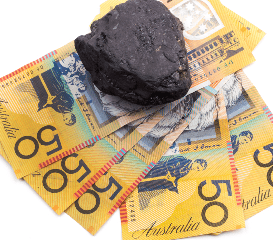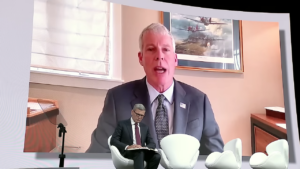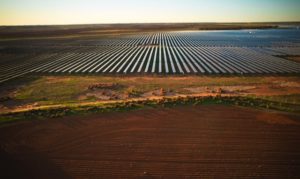The reinstatement of Nationals Senator Matt Canavan to the position of federal minister for resources and northern Australia has put the campaign to build a new coal-fired power generator in north Queensland right back on top of his political agenda.
He wants to use the government’s $5 billion Northern Australia Infrastructure Facility to back the project.
“I want to get a coal-fired power station in north Queensland (and there’s no reason) why that cannot be done through the NAIF,” Canavan told The Courier-Mail within hours of being cleared by the High Court over concerns of dual Australian-Italian citizenship.
But, as timing would have it, a new report from the Climate Council on the state of renewables in the “Sunshine State” was published on Tuesday.
And it happens to offer up five very good reasons why building a new coal plant in northern Queensland would be a really bad idea – for the state, for the nation, and for the world. It is timely, given that the state poll will be dominated by this issue, and that of the Stop Adani campaign,
1.It is prohibitively expensive, and a terrible use of public money
It’s all very well to talk about cheap, baseload coal power, but is there actually such a thing? Not really, no. Not in Australia, anyway. And certainly not when it comes to building new, so-called, high efficiency low-emissions coal-fired power generation.
As the table below shows, the construction of new renewable power technologies – including the solar thermal plant being built in Port Augusta, South Australia, by SolarReserve – are now cost competitive or cheaper than new coal and gas power plants, by a significant margin.
According to the data collected by the Climate Council, building new coal with carbon capture and storage would currently cost $A352/MWh, according to the BNEF 2017 data, while new large-scale solar PV can be built for as little as $78/MWh, and new wind farms for between $60-$118/MWh.
In August this year, for example, AGL Energy secured an off-take price of below $60/MWh through the sale of its 453MW Coopers Gap Wind Farm in Queensland’s south-east.
2. It will take too long
As well as being more expensive, it takes a lot longer to build a new coal-fired power plant than it does to build large-scale solar and/or wind farms with battery storage. According to the below table, it will take upwards of six years to build a new coal or gas power station in Queensland, in which time a massive pipeline of large-scale renewable energy projects are expected to be built, while battery storage costs continue to decline.
This not only means a long wait for new coal-fired power generating capacity, but a much higher chance of new fossil fuel plant winding up as stranded assets by the time they are finished, because better, cheaper technology has taken its place.
3. It’s a good chance to wind up as a stranded asset…
…and not just because of the long build time, the high generation costs, and the increasingly unattractive attached carbon liability. But because it is highly likely that new coal capacity just won’t be needed, because heavy industry and other major energy users in Australia are turning to renewable energy, all by themselves.
Just ask UK steel billionaire Sanjeev Gupta, who just this week revealed his plans building 1 gigawatt (1,000MW) of dispatchable renewables – solar, wind, battery and pumped hydro storage, and demand management – in and around Whyalla, where his major steel plant is located.
Certainly private investors aren’t interested in new coal, but are piling into the Australian renewables market. For example, British investment manager Foresight Group this month continued its solar buying spree in Australia, announcing new deals to acquire shares in three Canadian Solar projects in Queensland, with a combined capacity of 117 MW.
And just last week, the Asia-Pacific region’s largest renewables developer Equis Energy – which in August announced plans to build a massive 1,000MW solar farm in the heart of Queensland’s coal and gas region in the Surat Basin – sold its $5 billion portfolio of projects to a consortium of high powered global investors in a deal that is being described as the largest ever purchase of renewable energy generation assets.
4. Queensland doesn’t need it, and the current Queensland government doesn’t want it
That’s right; as the Climate Council report notes, the Australian Energy Market Operator has assessed supply in Queensland over the coming decade (and remember, it will take at least six years to build a new coal plant) and found that the state had “no material risk” of insufficient electricity supply.
Rather, says the CC report, “Queensland will have more than sufficient electricity supply, given AEMO’s assessment did not include additional capacity provided under the state’s reverse auctions for 300MW of new renewable electricity and 100MW of energy storage.”
Added to that, the report notes that Queensland has the greatest number of large-scale renewable energy projects under construction in Australia, representing a quarter of all new capacity being built around the nation, $1.6 billion in investment and over 1,300 new renewable energy construction jobs. Check out the table below. And more are being announced every week.
And then there’s state’s rooftop solar capacity – and Queensland has that in spades. Across the state, an average of 31.6 per cent of households now have rooftop solar, and 14 Queensland postcodes boast more than 50 per cent of households with solar panels installed, including Elimbah, at 63 per cent.
Recently announced new government incentives look set to give those numbers a fresh boost, both for household solar and in behind the meter battery storage. And why wouldn’t people install solar if they could? According to the report, Queensland households with rooftop PV use 18 per cent less electricity from the grid than the average residential user.
5. It will blow the state’s carbon budget, and blow out Australia’s
As the Climate Council report puts it, “building a new coal fired power station in Queensland would effectively lock in over 40 years of pollution. This is well beyond 2050 when the Queensland Government and Australian Government have committed to net zero emissions in line with the Paris Climate Agreement.”













